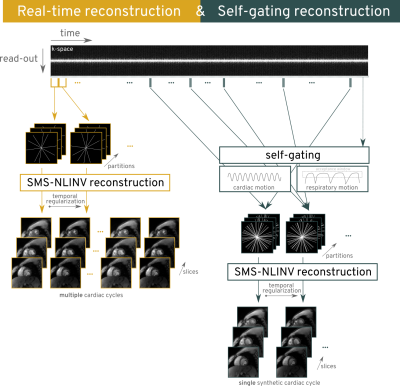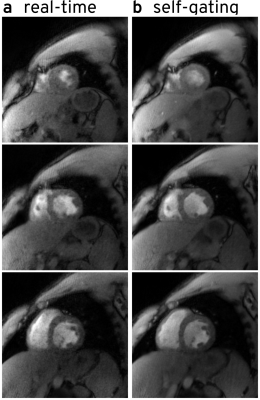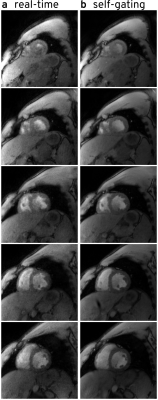0209
Self-Gated and Real-time Simultaneous Multi-Slice Cardiac MRI from the Same Acquisition1Intistut für Diagnostische und Interventionelle Radiologie, University Medical Center Göttingen, Göttingen, Germany, 2Partner Site Göttingen, German Centre for Cardiovascular Research (DZHK), Göttingen, Germany
Synopsis
Cardiac MRI requires fast and robust acquisition and reconstruction strategies to generate clinically reliable results. Using a combination of non-aligned radial Simultaneous Multi-slice (SMS) acquisitions and Regularized Nonlinear Inverse reconstruction, time-consistent movies of multiple slices can be generated. Here, we develop a self-gating technique for real-time radial SMS measurements which allows for the reconstruction of high-quality self-gated cine loops in addition to real-time movies from the same measurement.
Introduction and Purpose
Increasing imaging speed is of great importance in clinical practice and one of the main challenges in MRI research. In the past decade, fast single-slice real-time MRI techniques such as Regularized Nonlinear Inversion (NLINV) emerged which yield a time-resolution of 20ms1. Likewise, the technique of Simultaneous Multi-Slice (SMS) was shown to significantly speed up MRI measurements2,3. Recently, we introduced SMS-NLINV, a technique which combines the advantages of Simultaneous Multi-Slice and Regularized Nonlinear Inverse reconstruction and achieved a time-resolution of 33ms for three slices per frame in cardiac MRI4-6. This real-time method does not rely on ECG triggering or breath-holding and provides a sequence of several individual heart beats for multiple slices. We show that from the same data we can also reconstruct one high quality self-gated cine loop of a single synthetic heart beat with improved temporal resolution and image quality.Methods
Sequence. We use a 2D radial FLASH sequence with phase-modulated multiband RF excitation pulses to induce Fourier-encoding in partition direction. For each excitation we increase the projection angle about the 7th tiny golden angle7 $$$\Psi_7 \approx 23.6°$$$. In particular, this yields non-aligned spokes in partition direction which significantly improves image quality by exploiting three-dimensional sensitivity encoding4.
Reconstruction. The SMS-NLINV reconstruction algorithm4,8 jointly estimates coil sensitivities and image content for all slices by solving the nonlinear inverse problem $$$F(\boldsymbol{X}) = \boldsymbol{Y}$$$. Here, $$$\boldsymbol{Y}$$$ is the measured data, $$$\boldsymbol{X}$$$ is the objective, i.e. image content and coil sensitivities for all slices, and $$$F$$$ is the forward model. The problem is solved using the Iteratively Regularized Gauss Newton Method.
Self-Gating. We perform both respiratory and cardiac self-gating by using the motion information inherent in the 1D projection profile of the investigated volume, which can be generated by a 1D Fourier-transform of the partitions' DC components $$$k_x=k_y=0$$$. To extract cardiac motion we perform iterative bandpass filtering of the center of mass calculated from the 1D volume projection profile9. Respiratory motion estimation is done using a principle component analysis10 and coil clustering11 to detect the most prevalent signal variation modes in all coils. The data that match a predetermined respiratory gating window are used for image reconstruction.
Experiments
We perform one-minute free-breathing real-time FLASH SMS measurements with multiband factor mb=3 (TR=2.3 ms, slice distance 20 mm) and mb=5 (TR = 2.9 ms) on a human heart (short-axis view) without ECG triggering. We then reconstruct all acquired frames (real-time reconstruction) as well as one synthetic heart-beat (self-gated reconstruction) using SMS-NLINV with temporal regularization and a temporal median filter of length three. A schematic of the procedure is depicted in Fig. 1.Results and Discussion
Fig. 2a and 3a show one frame extracted from full real-time reconstructions for multiband factor mb=3 and mb=5. Both reconstructions provide satisfying image quality with 14 frames (mb=5) and 28 frames (mb=3) per heart beat. For the same data, we can use self-gating to obtain one synthetic heart beat consisting of 30 frames (Fig. 2b and 3b) with improved image quality and temporal resolution.Conclusion and Outlook
We demonstrated that a one-minute SMS scan can be used to obtain high-quality real-time reconstructions, which can be further improved using a combination of self-gating and SMS-NLINV. We furthermore showed that robust self-gating is also feasible with non-aligned spokes in partition direction, which enables sensitivity encoding in all three dimensions. In the future we want to extend SMS-NLINV for the reconstruction of Stack-of-Stars data and implement more elaborate regularization terms to fully exploit all available data.Acknowledgements
No acknowledgement found.References
[1] Uecker, M., Zhang, S., Voit, D., Karaus, A., Merboldt, K.-D. and Frahm, J. (2010), Real-time MRI at a resolution of 20 ms. NMR Biomed., 23: 986–994. doi:10.1002/nbm.1585
[2] Moeller S, Yacoub E, Olman CA, Auerbach E, Strupp J, Harel N, Ugurbil K. Multiband multislice GE-EPI at 7 Tesla, with 16-fold acceleration using partial parallel imaging with application to high spatial and temporal whole-brain fMRI. Magn Reson Med 2010;63: 1144–1153.
[3] Feinberg DA, Moeller S, Smith SM, Auerbach E, Ramanna S, Glasser MF, Miller KL, Ugurbil K, Yacoub E. Multiplexed echo planar imaging for sub-second whole brain FMRI and fast diffusion imaging. PLoS One 2010;5:e15710.
[4] Rosenzweig, S., Holme, H. C. M., Wilke, R. N., Voit, D., Frahm, J. and Uecker, M. (2017), Simultaneous multi-slice MRI using cartesian and radial FLASH and regularized nonlinear inversion: SMS-NLINV. Magn. Reson. Med.. doi:10.1002/mrm.26878
[5] Rosenzweig, S., Holme, H. C. M., Wilke, R. N. and Uecker, M. (2017), Simultaneous Multi-Slice Real-Time Imaging with Radial Multi-Band FLASH and Nonlinear Inverse Reconstruction, In Proc. Intl. Soc. Mag. Reson. Med. 25; 518.
[6] Rosenzweig, S. and Uecker, M. (2016), Reconstruction of multiband MRI data using Regularized Nonlinear Inversion, In Proc. Intl. Soc. Mag. Reson. Med 24; 3259.
[7] Wundrak, S., Paul, J., Ulrici, J., Hell, E., Geibel, M.-A., Bernhardt, P., Rottbauer, W. and Rasche, V. (2016), Golden ratio sparse MRI using tiny golden angles. Magn. Reson. Med., 75: 2372–2378. doi:10.1002/mrm.25831
[8] Uecker, M., Hohage, T., Block, K. T. and Frahm, J. (2008), Image reconstruction by regularized nonlinear inversion—Joint estimation of coil sensitivities and image content. Magn. Reson. Med., 60: 674–682. doi:10.1002/mrm.21691
[9] Liu, J., Spincemaille, P., Codella, N. C. F., Nguyen, T. D., Prince, M. R. and Wang, Y. (2010), Respiratory and cardiac self-gated free-breathing cardiac CINE imaging with multiecho 3D hybrid radial SSFP acquisition. Magn. Reson. Med., 63: 1230–1237. doi:10.1002/mrm.22306
[10] Pang, J., Sharif, B., Fan, Z., Bi, X., Arsanjani, R., Berman, D. S. and Li, D. (2014), ECG and navigator-free four-dimensional whole-heart coronary MRA for simultaneous visualization of cardiac anatomy and function. Magn. Reson. Med., 72: 1208–1217. doi:10.1002/mrm.25450
[11] Zhang, Tao, et al. "Robust self-navigated body MRI using dense coil arrays" Magn. Reson. Med. 76.1 (2016): 197-205.
Figures


